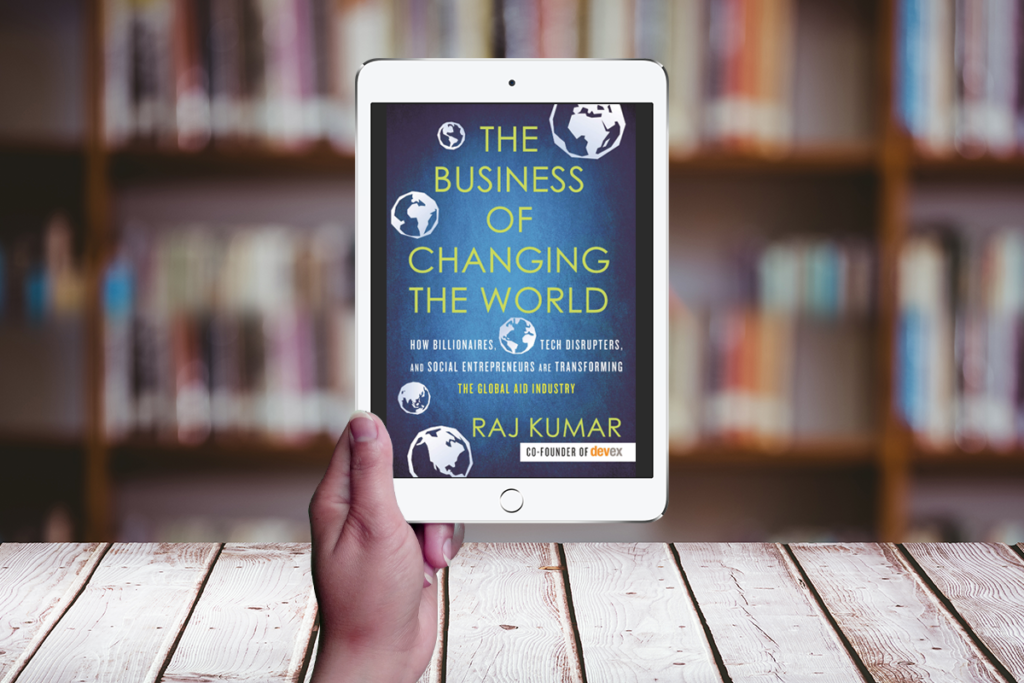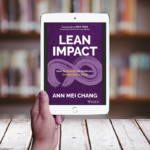Earlier this month my book club discussed The Business of Changing the World by Raj Kumar, co-founder of Devex. In the book, Kumar describes the differences between what he calls new aid and old aid. One club member started our discussion by commenting, “Reading this book felt a bit like when my son played the song “Hey Jude” for me and said, ‘Mom, listen to this great new song!’” Those of us who have been delivering aid within the industry for the past three or more decades know that many of the ideas underpinning Kumar’s “new aid” have been guiding principles for years. Still, the book offers many interesting insights and provided the fodder for a lively discussion. In this post, I start by summarizing several elements of the book, and then l share some of the club’s thoughts.
Billionaires
“The Billionaire Effect” is Kumar’s first chapter and he mentions the billionaire philanthropists often throughout the book. He compares the approaches of the billionaires to those of traditional aid agencies, like USAID, and he also compares the billionaires to each other. He argues that some of the larger new billionaire philanthropists are more results oriented than traditional aid. Billionaires can choose zero goals, like the Gates Foundation’s Global Polio Eradication Initiative, and invest significant funds to achieve those goals. The billionaires like this approach because they can achieve demonstrable, measurable results. In describing the approaches of Good Ventures and Give Well, Kumar shows that philanthropists also care about cost effectiveness in their funding and tend to be very selective in what they choose to support.
Kumar presents a matrix to compare the philanthropy approaches of three billionaire couples (p. 31). The three couples are Bill and Melinda Gates, Mark Zuckerberg and Priscilla Chan, and Jeff and MacKenzie Bezos. The biggest differences among the three are their operating models; the greatest similarity appears to be their willingness to court controversy, which is somewhat limited. Kumar is critical of Jeff Bezos for his lack of philanthropy, and Kumar’s voicing of this criticism is consistent with his view that we “need a highly engaged public encouraging results-oriented philanthropy and holding billionaires accountable when their giving isn’t generating or even targeting the results the world needs” (p. 41).
Social enterprises
Retail aid
Almost lost among Kumar’s examples of retail aid is a mention of governments and the roles that they play. He cites Lant Pritchett’s distinction between human development and national development. And then as soon as he mentions it, he drops it and goes back to describing the transformative impacts of retail aid. At the end of that chapter, he suggests that wholesale aid (roughly, big projects funded by big donors) will be forced to change in response to the expectations of aid recipients set by retail aid.
What the book club thought
New aid?
I’ll start with an anecdote that is reflective of our conversation. In Kumar’s chapter titled, “The ‘Pure’ Social Enterprise,” he lauds water.org for putting “a lot of thought into the endgame” (p. 99). He claims that “social entrepreneurs know to take into account parts and maintenance, as well as training and management, in their model” while traditional “charitable” approaches do not. One of our members pointed to this claim and exclaimed, “THIS IS WHAT I DID! THIS IS EXACTLY WHAT I DID!” By “this”, she didn’t mean she was taking photos at water wells as Kumar suggests, rather she was working as a technical advisor on USAID-funded projects to help local water officials manage and maintain their utilities after they were built. She was doing this 20 years ago, and part of the reason she is not doing this now is because many of the countries where she worked graduated from USAID. Others shared similar reactions – that the development work they were doing as far back as the 90s (no one admits to being older than that) was clearly aimed at creating sustainable change.
Her outcry directed us to the table on pages 135-6 where Kumar compares “old aid” to “new aid” (which he calls “open source aid” in the table). Some of his contrasts resonated, for example, the contrast between “problem & solution designed first” and “agile, iterative process”. We all have years of experience writing proposals for, and implementing, aid projects where the problems are diagnosed and the solutions designed up front, even for multi-year projects. Many donors are now adopting more agile and iterative approaches, for example by requesting human-centered design approaches or requiring co-creation workshops before solicitation. But some of his contrasts sparked laughter. A club member who is retired from USAID scoffed, “USAID is ideological?” I nearly choked on my wine retorting, “Logic models are new?”
What about governance?
Putting aside our confusion around what Kumar’s timeline cutoff between old and new is, the biggest concern we had about the book can be summed up by the question we kept coming back to, “What about governance?” Looking around the room, I realized that the club members have all worked primarily in the sectors of economic and democratic governance and financial and private sector market development, or as we like to say, EG, DG, FSD, and PSD. Sure, we sometimes think of those we help as beneficiaries as Kumar suggests, but more often we think of them as voters, citizens, government officials, legislators, lenders, taxpayers, workers, entrepreneurs, communities, civil society and so on. For those of us working in these sectors, systems thinking is how we have always worked. And we worry that systems like the rule of law, democratic governance and well-regulated markets are getting short shrift from the billionaires, big businesses and retail players.
Why didn’t he ask us?
Everyone at the book club meeting was glad to have read the book and learned from it. Kumar is an influencer in our industry, and his views are important. Kumar is certainly right that our industry is changing fast, and his book helps us to understand some of these changes. We have already begun to make it better.
Photo credits: Mockup psd created by Ydlabs – Freepik.com, Background image created by Creativeart – Freepik.com



